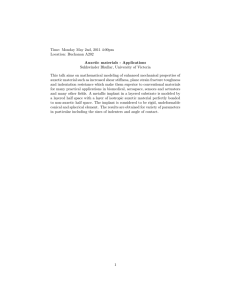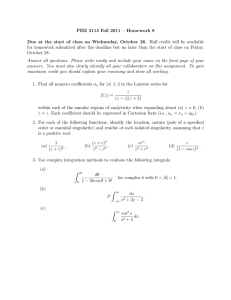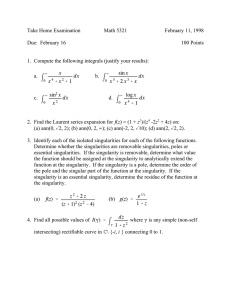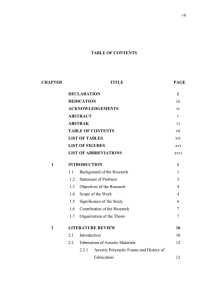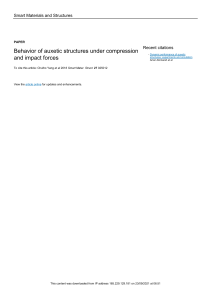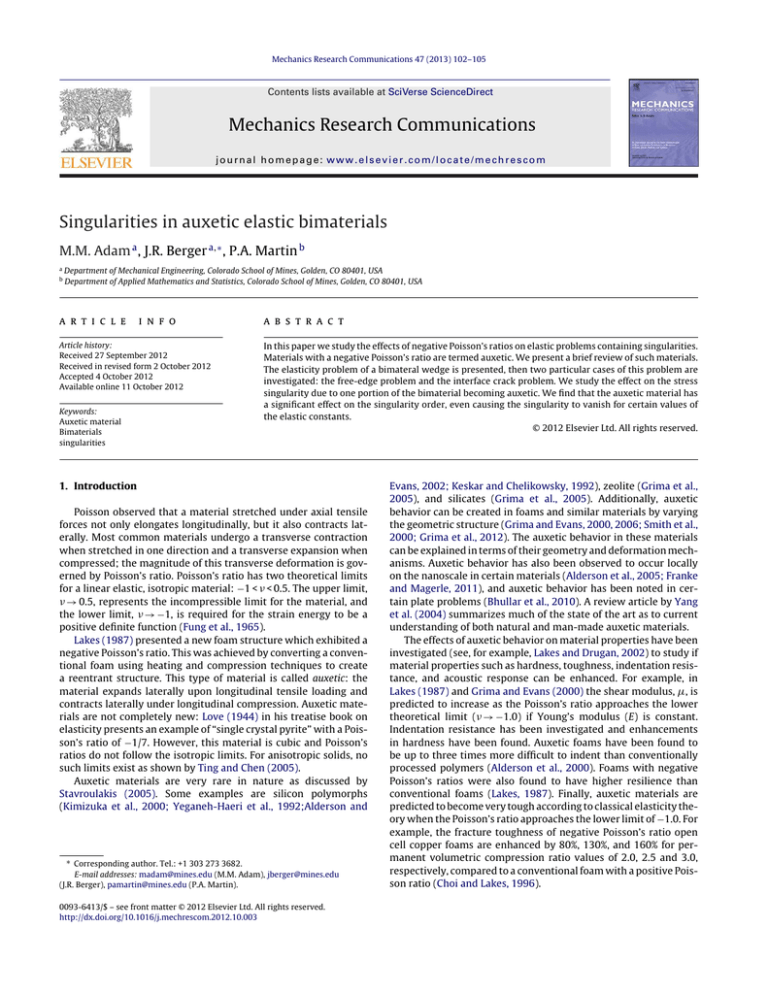
Mechanics Research Communications 47 (2013) 102–105
Contents lists available at SciVerse ScienceDirect
Mechanics Research Communications
journal homepage: www.elsevier.com/locate/mechrescom
Singularities in auxetic elastic bimaterials
M.M. Adam a , J.R. Berger a,∗ , P.A. Martin b
a
b
Department of Mechanical Engineering, Colorado School of Mines, Golden, CO 80401, USA
Department of Applied Mathematics and Statistics, Colorado School of Mines, Golden, CO 80401, USA
a r t i c l e
i n f o
Article history:
Received 27 September 2012
Received in revised form 2 October 2012
Accepted 4 October 2012
Available online 11 October 2012
Keywords:
Auxetic material
Bimaterials
singularities
a b s t r a c t
In this paper we study the effects of negative Poisson’s ratios on elastic problems containing singularities.
Materials with a negative Poisson’s ratio are termed auxetic. We present a brief review of such materials.
The elasticity problem of a bimateral wedge is presented, then two particular cases of this problem are
investigated: the free-edge problem and the interface crack problem. We study the effect on the stress
singularity due to one portion of the bimaterial becoming auxetic. We find that the auxetic material has
a significant effect on the singularity order, even causing the singularity to vanish for certain values of
the elastic constants.
© 2012 Elsevier Ltd. All rights reserved.
1. Introduction
Poisson observed that a material stretched under axial tensile
forces not only elongates longitudinally, but it also contracts laterally. Most common materials undergo a transverse contraction
when stretched in one direction and a transverse expansion when
compressed; the magnitude of this transverse deformation is governed by Poisson’s ratio. Poisson’s ratio has two theoretical limits
for a linear elastic, isotropic material: −1 < < 0.5. The upper limit,
→ 0.5, represents the incompressible limit for the material, and
the lower limit, → −1, is required for the strain energy to be a
positive definite function (Fung et al., 1965).
Lakes (1987) presented a new foam structure which exhibited a
negative Poisson’s ratio. This was achieved by converting a conventional foam using heating and compression techniques to create
a reentrant structure. This type of material is called auxetic: the
material expands laterally upon longitudinal tensile loading and
contracts laterally under longitudinal compression. Auxetic materials are not completely new: Love (1944) in his treatise book on
elasticity presents an example of “single crystal pyrite” with a Poisson’s ratio of −1/7. However, this material is cubic and Poisson’s
ratios do not follow the isotropic limits. For anisotropic solids, no
such limits exist as shown by Ting and Chen (2005).
Auxetic materials are very rare in nature as discussed by
Stavroulakis (2005). Some examples are silicon polymorphs
(Kimizuka et al., 2000; Yeganeh-Haeri et al., 1992;Alderson and
∗ Corresponding author. Tel.: +1 303 273 3682.
E-mail addresses: madam@mines.edu (M.M. Adam), jberger@mines.edu
(J.R. Berger), pamartin@mines.edu (P.A. Martin).
0093-6413/$ – see front matter © 2012 Elsevier Ltd. All rights reserved.
http://dx.doi.org/10.1016/j.mechrescom.2012.10.003
Evans, 2002; Keskar and Chelikowsky, 1992), zeolite (Grima et al.,
2005), and silicates (Grima et al., 2005). Additionally, auxetic
behavior can be created in foams and similar materials by varying
the geometric structure (Grima and Evans, 2000, 2006; Smith et al.,
2000; Grima et al., 2012). The auxetic behavior in these materials
can be explained in terms of their geometry and deformation mechanisms. Auxetic behavior has also been observed to occur locally
on the nanoscale in certain materials (Alderson et al., 2005; Franke
and Magerle, 2011), and auxetic behavior has been noted in certain plate problems (Bhullar et al., 2010). A review article by Yang
et al. (2004) summarizes much of the state of the art as to current
understanding of both natural and man-made auxetic materials.
The effects of auxetic behavior on material properties have been
investigated (see, for example, Lakes and Drugan, 2002) to study if
material properties such as hardness, toughness, indentation resistance, and acoustic response can be enhanced. For example, in
Lakes (1987) and Grima and Evans (2000) the shear modulus, , is
predicted to increase as the Poisson’s ratio approaches the lower
theoretical limit ( → −1.0) if Young’s modulus (E) is constant.
Indentation resistance has been investigated and enhancements
in hardness have been found. Auxetic foams have been found to
be up to three times more difficult to indent than conventionally
processed polymers (Alderson et al., 2000). Foams with negative
Poisson’s ratios were also found to have higher resilience than
conventional foams (Lakes, 1987). Finally, auxetic materials are
predicted to become very tough according to classical elasticity theory when the Poisson’s ratio approaches the lower limit of −1.0. For
example, the fracture toughness of negative Poisson’s ratio open
cell copper foams are enhanced by 80%, 130%, and 160% for permanent volumetric compression ratio values of 2.0, 2.5 and 3.0,
respectively, compared to a conventional foam with a positive Poisson ratio (Choi and Lakes, 1996).
M.M. Adam et al. / Mechanics Research Communications 47 (2013) 102–105
103
in the stress field on the wedge angles and the elastic constants
of the materials was also investigated by Hein and Erdogan (1971).
Numerical results of several angle geometries for all relevant material constants combinations were produced. Finally, we note that
Green’s function methods have also been used successfully on the
free-edge problem. The anisotropic problem was considered by
Tewary (1991), where the Green’s function was represented by an
exact integral. Both the displacement and the stress Green’s function were obtained. A Green’s function method was also employed
by Martin (2003) where a reduced equation for calculating the singularity order was found. An anisotropic bimaterial problem was
also considered by Berger et al. (1998) where it was noted that the
free edge singularity vanishes for certain free-surface angles and
elastic constants combinations.
3. Formulation
In this section, we review the analytical solution for the bimaterial wedge as introduced in previous papers, see for example
Bogy (1968), Ding and Kumosa (1994). To be definite, we consider
plane-strain problems; similar results are available for plane-stress
problems. Typical solutions use an Airy stress function in polar
coordinates, (r, ) (Williams, 1952), written in each portion of
the bimaterial,
Fig. 1. General elastic bimaterial problem.
The motivation for the present paper is to investigate problems
in elastic bimaterials when one portion of the bimaterial is auxetic.
Typical problems of this nature are the free-edge singularity (which
can be useful in investigating delaminatation failures in bimaterials) and the interface crack problem. To generalize the problem, we
present results for both the free-edge and interface crack problems
over the entire range of permissible Poisson ratios where the effect
of a material becoming auxetic on the stress singularity order may
be readily seen.
j (r, )
We consider the general bimaterial problem shown in Fig. 1.
Both Material 1 and Material 2 are taken to be linear, elastic,
isotropic, and homogeneous. Material j has Poisson’s ratio j , shear
modulus j , and Young’s modulus Ej , j = 1, 2. We will assume the
two materials are perfectly bonded at the planar interface so displacements and tractions are continuous across the interface. The
local polar coordinate system r, is positioned at the root of the
notch, and the notch-face angle is assumed to be symmetric with
respect to the interface. We focus on two specific problems: the
free-edge problem ( = /2 in Fig. 1) and the interface crack problem
( = ). Of particular interest in both problems is the nature of the
increase in stress (if any) as r → 0.
The singularity order ı has been studied extensively in isotropic
bimaterials. For interface cracks, solutions of the type ∼ rı have
been obtained where ı is complex valued. The free-edge problem has been extensively studied by Bogy (1968, 1970) and others,
and the stress field solution was of the type rı where ı was realvalued depending on the elastic properties of the two materials.
Dundurs (1969) reduced the number of parameters that the stress
field depends on from three to two and used these parameters to
express the solution in a more compact way.
The plane problem of bonded dissimilar wedges of arbitrary
angle subjected to general forms of loading was studied by Hein
and Erdogan (1971). The solution was obtained by solving two simpler problems where the solution is given by the sum of solutions of
the two separated problems. The dependence of singularity order
j = 1, 2
(1)
where Fj () can be determined from the governing differential
equation for , ∇ 4 = 0. The stress components in each portion
of the bimaterial are then
(j)
rr
= (ı + 1)r ı ı[Aj sin ı − Bj cos ı]
(2)
−(ı + 2)[Cj sin(ı + 2) + Dj cos(ı + 2)] ,
(j)
r
= (ı + 1)r ı ı[Aj cos ı + Bj sin ı]
(3)
+(ı + 2)[Cj cos(ı + 2) − Dj sin(ı + 2)] ,
(j)
2. Singularities in bimaterials
= r ı Fj (),
= (ı + 1)(ı + 2)r ı Aj sin ı + Bj cos ı
(4)
+Cj sin(ı + 2) + Dj cos(ı + 2) ,
where j = 1, 2 indicates if the stress component is in Material 1 or 2.
Using similar notation, the displacements in each portion of the
bimaterial are
(j)
ur
=
r ı+1
Ej
ı + j (ı + 2) [Aj sin ı − Bj cos ı]
(5)
−(ı + 2)(1 + j )[Cj sin(ı + 2) + Dj cos(ı + 2)] ,
(j)
u
=
r ı+1
{−(j (ı + 2) + (ı + 6))[Aj cos ı + Bj sin ı]
Ej
(6)
+(ı + 2)(1 + j )[Cj cos(ı + 2) + Dj sin(ı + 2)]}.
For continuity of displacement and traction at the interface, = 0,
(1)
(2)
u (r, 0) = u (r, 0),
(1)
(2)
r (r, 0) = r (r, 0).
ur (r, 0) = ur (r, 0),
(r, 0) = (r, 0),
(1)
(2)
(1)
(2)
(7)
(8)
Finally, the traction-free surface conditions are
(1)
(2)
(1)
(2)
(r, ) = (r, −) = r (r, ) = r (r, −) = 0.
(9)
Substituting the stress and displacement equations in the boundary
and continuity conditions, we obtain eight linear equations in the
eight unknown values of Aj , Bj , Cj , and Dj which can be written
in matrix form as Ax = 0. For a non-trivial solution we then have
det A = 0, which yields the singularity order ı.
104
M.M. Adam et al. / Mechanics Research Communications 47 (2013) 102–105
Fig. 2. Singularity order ı for the free-edge problem as a function of 1 (with
2 = 0.30) for 2 ≤ E = E1 /E2 ≤ 1000.
Fig. 3. Singularity order ı for the free-edge problem as a function of 1 (with
2 = 0.30) for 1.5 ≤ E ≤ 4.5.
5. The interface crack problem
4. The free-edge problem
For this problem, we consider the effects of an auxetic material
on the singularity at the intersection between an interface and the
free surface of the bimaterial. Following Martin (2003), the singularity order for = /2 can be computed from
det A = −44 (ı + 1)2 [(1 − 1 )2 + (1 − 2 )1 ]2 (ı) = 0
2
+(ı + 1)
(ı + 1)2 (˛ − ˇ)2 − ˛
2
(13)
where the second term arises from the imaginary part of the singularity order and is usually referred to in the literature as the
oscillatory part of the singularity. This can be computed in planestrain as (Gu and Belytschko, 1994) as
(11)
Im(ı) =
= (ˇ2 − 1)S 4 + 1 + 2(ı + 1)2 (˛ − ˇ)ˇ S 2
∼r −1/2 cos(Im(ı) log r)
(10)
where
(ı)
For this problem, we investigate the effect of an auxetic material
on the singularity at the tip of an interface crack, that is, when
= . The stress field near the tip of the crack varies, for example,
as (Atkinson, 1979)
,
1
(3 − 41 )2 + 1
.
log
2
(3 − 42 )1 + 2
(14)
(12)
When the two portions of the bimaterial are closely matched
elastically, the imaginary part of the singularity order is very small
as expected. In Fig. 4 we have plotted Im(ı) for a variety of ratios
1 /2 as a function of 1 . As with the free-edge problem, we have
kept 2 = 0.30 for these calculations. We note in the figure that, in
In the majority of the literature (see, for example, Hutchinson and
Suo, 1992), physically admissible values for the Dundurs constants
are restricted to lie within the parallelogram enclosed by ˛ = ±1
and ˛ − 4ˇ = ±1 in the (˛, ˇ) plane. However, this result assumes
that Poisson’s ratio is positive. If we permit auxetic materials, the
parallelogram is 50% larger; it is enclosed by ˛ = ±1 and ˛ − 83 ˇ =
±1.
To examine the influence of one portion of the bimaterial
becoming auxetic, we calculate the singularity order, ı, from Eq.
(11) as we vary 1 . For this calculation we fix 2 = 0.30 and allow
the elastic moduli ratio, E = E1 /E2 , to vary. The first set of results
is shown in Fig. 2, where we plot ı as a function of 1 . We take
values of 1 across the entire range of permissible values of the
Poisson ratio, −1 < 1 < 0.5. Note in the figure that the singularity
order, ı, becomes increasingly negative as E is increased for fixed
1 . Also, once Material 1 becomes auxetic (1 < 0), the singularity
order is significantly affected by the Poisson ratio. In certain cases
the singularity order decreases over 18% due to Material 1 becoming auxetic. Finally, in Fig. 2 we note that for E = 2, the singularity
disappears when 1 decreases below −0.4. This is explored in more
detail in Fig. 3 for moduli ratios of 1.5 ≤ E ≤ 4.5. In Fig. 3, note that
if E ≥ 3, the singularity cannot be eliminated.
Fig. 4. Imaginary part of the singularity order ı for the interface crack problem as a
function of 1 (with 2 = 0.30) for 1.5 ≤ E1 /E2 ≤ 1000.
S = − sin 12 (ı + 1), and ˛, ˇ are Dundurs constants (Dundurs,
1969); for plane-strain problems,
˛=
E−1
,
E+1
ˇ=
(1 − 22 )1 − (1 − 21 )2
,
2(1 − 2 )1 + 2(1 − 1 )2
E=
E1
.
E2
M.M. Adam et al. / Mechanics Research Communications 47 (2013) 102–105
105
Table 1
Values of 1 where Im(ı) = 0 (2 = 0.3).
1 /2
1
1.5
0.2
2.0
0.1
2.5
0.0
3.0
−0.1
3.5
−0.2
4.0
−0.3
general, a negative Poisson’s ratio causes the oscillatory singularity
to decrease when compared to cases where the Poisson’s ratio is
positive. Of particular interest are cases where the decrease due to
1 becoming negative can actually drive Im(ı) to zero. In Table 1
we present values for 1 where Im(ı) = 0 for various ratios 1 /2 .
Note in the table that if 1 /2 > 2.5, the material must be auxetic
in order for the crack-tip singularity to be purely real.
6. Summary
In this paper, we have investigated stress singularities in elastic
bimaterials where we allow the Poisson’s ratio of one portion of
the bimaterial to vary completely over −1 < < 0.5. Our motivation
for this study comes from recent discoveries of auxetic materials,
and how this might affect stress singularities in such problems. We
found that when one portion of the bimaterial becomes auxetic,
the effect on either the free-edge or interface crack singularity can
be profound, even causing it to vanish given appropriate values
of the remaining elastic constants. As more auxetic materials are
developed, this fact could lead to strategies helping to suppress
delamination or fracture failures in these bimaterials.
Acknowledgements
The authors acknowledge the support of the Army Research
Office, grant number DAAD19-01-1-0590, to the Colorado School
of Mines. Helpful discussions with Prof. I. Reimanis of the Department of Metallurgical and Materials Engineering at the Colorado
School of Mines are gratefully acknowledged.
References
Alderson, A., Evans, K.E., 2002. Molecular origin of auxetic behavior in tetrahedral
framework silicates. Physical Review Letters 89, 225503–225507.
Alderson, K.L., Fitzgerald, A., Evans, K.E., 2000. The strain dependent indentation
resilience of auxetic microporous polyethylene. Journal of Materials Science 35,
4039–4047.
Alderson, A., Alderson, K.L., Evans, K.E., Grima, J.N., Williams, M.R., Davies, P.J., 2005.
Modeling the deformation mechanisms, structure-property relationships and
applications of auxetic nanomaterials. Physical Status Solidi B 242, 499–508.
Atkinson, C., 1979. Stress singularities and fracture mechanics. Applied Mechanics
Reviews 32, 123–135.
Berger, J.R., Martin, P.A., Lien, J.P., 1998. Reduction of free-edge stress intensities in
anisotropic bi-materials. International Journal of Fracture 91, 165–177.
Bhullar, S.K., Wegner, J.L., Mioduchowski, A., 2010. Auxetic behavior of a thermoelastic layered plate. Journal of Engineering and Technology Research 2, 161–167.
Bogy, D.B., 1968. Edge-bonded dissimilar orthogonal elastic wedges under normal
and shear loading. Journal of Applied Mechanics 35, 460–466.
4.5
−0.4
5.0
−0.5
5.5
−0.6
6.0
−0.7
6.5
−0.8
7.0
−0.9
Bogy, D.B., 1970. On the problem of edge-bonded elastic quarter-planes loaded at
the boundary. International Journal of Solids and Structures 6, 1287–1313.
Choi, J.B., Lakes, R.S., 1996. Fracture toughness of re-entrant foam materials with
a negative Poisson’s ratio: experiment and analysis. International Journal of
Fracture 80, 73–83.
Ding, S., Kumosa, M., 1994. Singular stress behavior at an adhesive interface corner.
Engineering Fracture Mechanics 47, 503–519.
Dundurs, J., 1969. Discussion of Bogy (1968). Journal of Applied Mechanics 36,
650–651.
Franke, M., Magerle, R., 2011. Locally auxetic behavior of elastometric polypropylene
on the 100 nm length scale. ACS Nano 5, 4886–4891.
Fung, Y.C., 1965. Foundations of Solid Mechanics. Prentice Hall, Englewood Cliffs, NJ.
Grima, J.N., Evans, K.E., 2000. Auxetic behavior from rotating squares. Journal of
Materials Science Letters 19, 1563–1565.
Grima, J.N., Evans, K.E., 2006. Auxetic behavior from rotating triangles. Journal of
Materials Science 41, 3193–3196.
Grima, J.N., Gatt, R., Alderson, A., Evans, K.E., 2005. On the origin of auxetic behavior
in the silicate ˛-cristobalite. Journal of Materials Chemistry 15, 4003–4005.
Grima, J.N., Chetcuti, E., Manicardo, E., Attard, D., Camilleri, M., Gatt, R., 2012. On the
auxetic properties of generic rotating rigid triangles. Proceeding of the Royal
Society A 468, 810–830.
Gu, L., Belytschko, T., 1994. A numerical study of stress singularities in a two-material
wedge. International Journal of Solids and Structures 31, 865–889.
Hein, V.L., Erdogan, F., 1971. Stress singularities in a two-material wedge. International Journal of Fracture Mechanics 7, 317–330.
Hutchinson, J.W., Suo, Z., 1992. Mixed mode cracking in layered materials. Advances
in Applied Mechanics 29, 63–192.
Keskar, N.R., Chelikowsky, J.R., 1992. Structural properties of nine silica polymorphs.
Physical Review B 46, 1–13.
Kimizuka, H., Kaburaki, H., Kogure, Y., 2000. Mechanism for negative Poisson ratios
over the ˛-ˇ transition of cristobalite, SiO2 : A molecular-dynamics study. Physical Review Letters 84, 5548–5551.
Lakes, R.S., Drugan, W.J., 2002. Dramatically stiffer elastic composite materials due
to a negative stiffness phase? Journal of the Mechanics and Physics of Solids 50,
979–1009.
Lakes, R.S., 1987. Foam structures with a negative Poisson’s ratio. Science 235,
1038–1040.
Love, A.E.H., 1944. A Treatise on the Mathematical Theory of Elasticity, 4th edition.
Dover Publications, New York, New York.
Martin, P.A., 2003. On Green’s function for a bimaterial elastic half-plane. International Journal of Solids and Structures 40, 2101–2119.
Smith, C.W., Grima, J.N., Evans, K.E., 2000. A novel mechanism for generating auxetic
behaviour in reticulated foams: missing rib foam model. Acta Materialia 48,
4349–4356.
Stavroulakis, G.E., 2005. Auxetic behavior: appearance and engineering applications.
Physical Status Solidi B 242, 710–720.
Tewary, V.K., 1991. Elastic Green’s function for a bi-material composite solid containing a free surface normal to the interface. Journal of Materials Research 6,
2592–2608.
Ting, T.C.T., Chen, T., 2005. Poisson’s ratio for anisotropic elastic materials can
have no bounds. Quarterly Journal of Mechanics and Applied Mathematics 58,
73–82.
Williams, M.L., 1952. The stress around a fault or crack in dissimilar media. Bulletin
of the Seismological Society of America 49, 199–204.
Yang, W., Li, Z.-M., Shi, W., Xie, B.-H., Yang, M.-B., 2004. Review on auxetic materials.
Journal of Materials Science 39, 3269–3279.
Yeganeh-Haeri, A., Weidner, D.J., Parise, J.B., 1992. Elasticity of ˛-cristobalite: A
silicon dioxide with a negative Poisson’s ratio. Science 257, 650–652.

